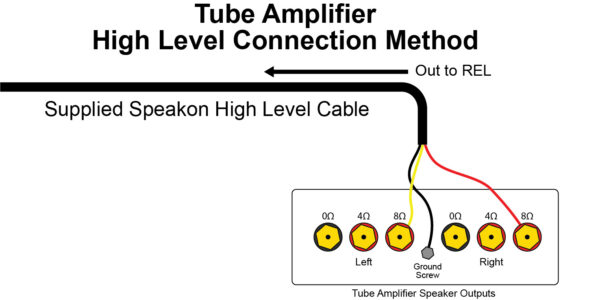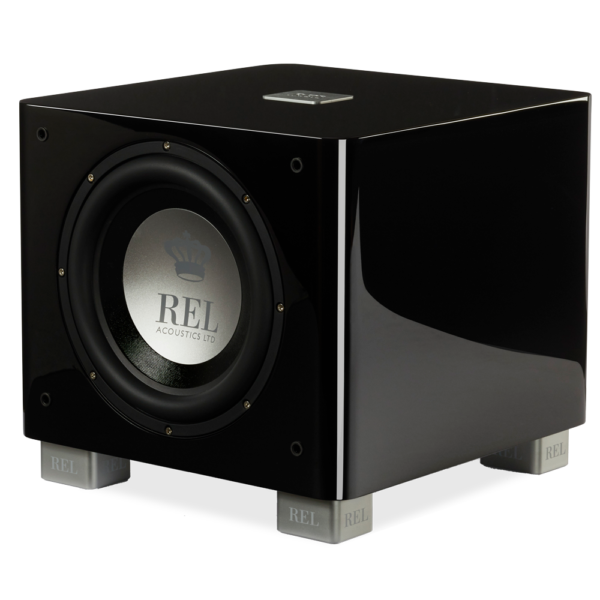Blog
How to Connect A REL
Connecting High Level To Tube Amplifiers
The output circuit of most vacuum tube (valve) amplifiers features an output transformer—generally offering multiple impedances. The most common type offers 4, 8 and 16 ohm connections (some offer 2, 4 and 8) A transformer is necessary because the electrical load of a speaker is very low impedance and tubes like to “see” very high impedances. The transformer allows the load impedance of your speakers to be matched to the ideal impedance that the tube wants to drive. The following provides guidance in how to correctly connect REL’s High Level Connection to common multiple output impedance tube amplifiers*.
Transformers are designed so that the speaker load winding (also referred to as a secondary) can be used with a variety of speaker impedances. This is done by winding the secondary to work with the highest desired speaker impedance, then includes a connection at half the full winding, then a quarter of the full winding. These multiple speaker output connections are commonly referred to as taps. For example, a common secondary is wound to connect to a maximum speaker load of 16 ohms, and then tapped for use with 8 ohm and 4 ohm speakers.
It is common for vacuum tube power amplifiers to have three sets of output connections. Since the REL high level connections draws no current, it is best to use it with taps intended for driving higher impedances such as 8, or even 16 ohms.
*We suggest starting by connecting the RED and YELLOW “hot” wires of the REL high level cable to the 8 ohm speaker outputs. This is recommended even if your main speakers are connected to 4 ohm (or 2 ohm) outputs because the gain of RELs is designed to follow the longstanding industry practice of using 8 ohm as a standard. Selecting a lower impedance for the REL connection will result in MUCH lower output. Connect the BLACK wire of the high level cable to a ground lug or to chassis ground.
Note: Should your tube amp be integrated into a theatre system, leave the BLACK wire disconnected because the LFE connection will likely providing the ground reference to the REL and connecting to 0 ohms at the rear of the amplifier may induce hum by creating a ground loop.
Note: If you are using Audio Research Reference power amplifiers please see
The output circuit of most vacuum tube (valve) amplifiers features an output transformer—generally offering multiple impedances. The most common type offers 4, 8 and 16 ohm connections (some offer 2, 4 and 8) A transformer is necessary because the electrical load of a speaker is very low impedance and tubes like to “see” very high impedances. The transformer allows the load impedance of your speakers to be matched to the ideal impedance that the tube wants to drive. The following provides guidance in how to correctly connect REL’s High Level Connection to common multiple output impedance tube amplifiers*.
Transformers are designed so that the speaker load winding (also referred to as a secondary) can be used with a variety of speaker impedances. This is done by winding the secondary to work with the highest desired speaker impedance, then includes a connection at half the full winding, then a quarter of the full winding. These multiple speaker output connections are commonly referred to as taps. For example, a common secondary is wound to connect to a maximum speaker load of 16 ohms, and then tapped for use with 8 ohm and 4 ohm speakers.
It is common for vacuum tube power amplifiers to have three sets of output connections. Since the REL high level connections draws no current, it is best to use it with taps intended for driving higher impedances such as 8, or even 16 ohms.
We suggest starting by connecting the RED and YELLOW “hot” wires of the REL high level cable to the 8 ohm speaker outputs. This is recommended even if your main speakers are connected to 4 ohm (or 2 ohm) outputs because the gain of RELs is designed to follow the longstanding industry practice of using 8 ohm as a standard. Selecting a lower impedance for the REL connection will result in MUCH lower output. Connect the BLACK wire of the high level cable to a ground lug or to chassis ground.
Note: Should your tube amp be integrated into a theatre system, leave the BLACK wire disconnected because the LFE connection will likely providing the ground reference to the REL and connecting to 0 ohms at the rear of the amplifier may induce hum by creating a ground loop. If you are using Audio Research Reference power amplifiers please see the REL connection guide elsewhere on this website for these amplifiers as they use a unique ground scheme.
the REL connection guide elsewhere on this website for these amplifiers as they use a unique ground scheme.












